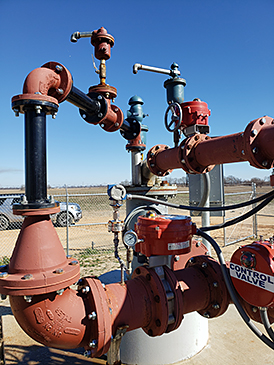Injecting New Life into an Old Aquifer

Pumps extract water from beneath the Tallahatchie River through this wellhead and injects it into the Mississippi River Valley Alluvial Aquifer. (Photo by Matt VanHattem)
Half the water used to irrigate farms in the United States comes from wells that reach into underground aquifers. Groundwater also is a key source of drinking water. The problem is, we’re pumping so much water from these aquifers that we’re in danger of draining them.
Aquifers are like underground lakes, where geologic formations of rock and sand are permeable enough to hold vast quantities of water. There are 66 principal aquifers in the United States, and many are emptying faster than nature can replenish them.
According to Andy O’Reilly, hydrologist with the Agricultural Research Service’s (ARS) Watershed Physical Processes Research (WPPR) unit, part of the National Sedimentation Laboratory in Oxford, MS, researchers have found a way to rapidly and safely recharge the Mississippi River Valley Alluvial Aquifer (MRVAA). The scientists are using the Groundwater Transfer and Injection Pilot (GTIP) project to leverage the natural process of refilling an aquifer.
Natural recharging occurs through a filtration process, in which rainfall or river water soaks through the ground – being purified along the way – until it reaches the aquifer. Because only about 5% of rainfall makes it to the aquifer, this recharging process takes a long time. According to O’Reilly, the GTIP project speeds up the process by collecting naturally filtered river water from a well next to the Tallahatchie River in the Mississippi Delta, pumping it through a pipeline, and then injecting it into the aquifer. GTIP uses two wells at a location where groundwater depletion of the aquifer is severe.
In experiments ranging from 3 to 6 months of continuous operation, researchers have proven that their technology can increase the amount of water in the aquifer under the Delta. O’Reilly said that water thickness (depth) of the aquifer increased from 1 to 7 feet within a radius of 1 mile from the injection wells.
“The MRVAA is the second most highly pumped of the principal aquifers, at 12.1 billion gallons per day (in 2015),” he explained. “(These) long-term declines in groundwater levels and [our] current water use practices are unsustainable.”
While relatively new to the Delta region, the process of purposefully recharging aquifers – commonly called managed aquifer recharge (MAR) – has been conducted safely in Europe since the 19th century and in the United States since the last century. According to O’Reilly, a key aspect of the GTIP project is the use of safe – naturally filtered – river water.
Riverbank filtration uses natural physical, chemical, and microbiological processes to improve the quality of river water. “Physical processes remove larger particles by straining [through sand and soil]; chemical processes add minerals to the water; and microbiological processes both add minerals and remove certain contaminants, such as nitrates,” he explained. To ensure quality and safety, researchers constantly monitor system operations and effects on the aquifer and surrounding environment.
The use of MAR in the Mississippi Delta region moves water from where it’s available to where it’s needed, like the central portion of the Delta where groundwater depletion is most severe. Once injected into the aquifer, water will naturally redistribute to where it can support natural groundwater-dependent ecosystems and agricultural production.
Traditional water management and conservation practices alone are not expected to stabilize or reverse the groundwater depletion trend in the Mississippi Delta, O’Reilly said. The consequences of letting aquifer water levels get too low include harming surface aquatic ecosystems, increasing the costs of pumping groundwater from greater depths, and not having enough water to meet agricultural or drinking needs.
“We are providing science to support sustainable agroecosystems in the Delta region of Mississippi,” O’Reilly said. “Agriculture is the largest economic driver in the Delta, so increasing water security would both support sustainable agricultural production and promote economic opportunity in the Delta.” – by Scott Elliott, ARS Office of Communications
You May Also Like:

